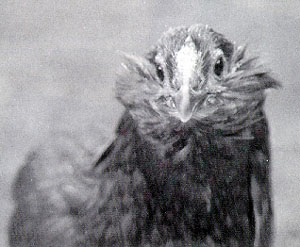Appenzell Bearded Hens
 Since the middle of the 1860s Bearded Hens have been bred from breeds of country hens
in the Appenzell Forecountry. Out of this came a powerful hen which, with its relatively
small rosecomb and throat and ear lobes protected by its beard, has little surface
area for the cold to attack. The breed occurred in two colors: black and partridge.
A cross with Andalusians developed a blue color.
Since the middle of the 1860s Bearded Hens have been bred from breeds of country hens
in the Appenzell Forecountry. Out of this came a powerful hen which, with its relatively
small rosecomb and throat and ear lobes protected by its beard, has little surface
area for the cold to attack. The breed occurred in two colors: black and partridge.
A cross with Andalusians developed a blue color.
Characteristics
This light, temperamental hen with a proud posture is equipped with all advantages for a rough mountain climate. The beard covers the sensitive spots of the hen. The mid-high positioning and the powerful wings make it possible for the hen to seek out its own food for the most part. The Appenzell Bearded Hen lays around 150 white-shelled eggs in the first year, each weighing approx. 55g. The brooding instinct is only moderately developed.
Standard Weights
Hens weigh 1.6 to 1.8 kg, roosters 2.0 to 2.3 kg. Bearded hens lay approx. 150 white-shelled eggs in the first year, each weighing approx. 55g. The brooding instinct is only moderately developed.
Breeding Organization
In the early summer 1985/86 Pro Specie Rara was made aware of the disappearance of the partridge-colored Appenzeller Bearded Hen. Only nine mutually related breeding groups were present at six breeders. In cooperation with the Appenzeller Hen Club an emergency program was set up. In the meantime the stock has recovered somewhat, but as in other cases evidences of inbreeding have occurred in this color hen. The black bearded hens are not in danger.
References
Endangered Domestic Animal Breeds 1995, Pro Specie Rara, Engelgasse 12a, CH-9000 St. Gallen, Switzerland, Telefon 071/222 74 20, Fax 071/223 74 01. German Translation provided by John te Velde, Associate Professor of German, Oklahoma State University
